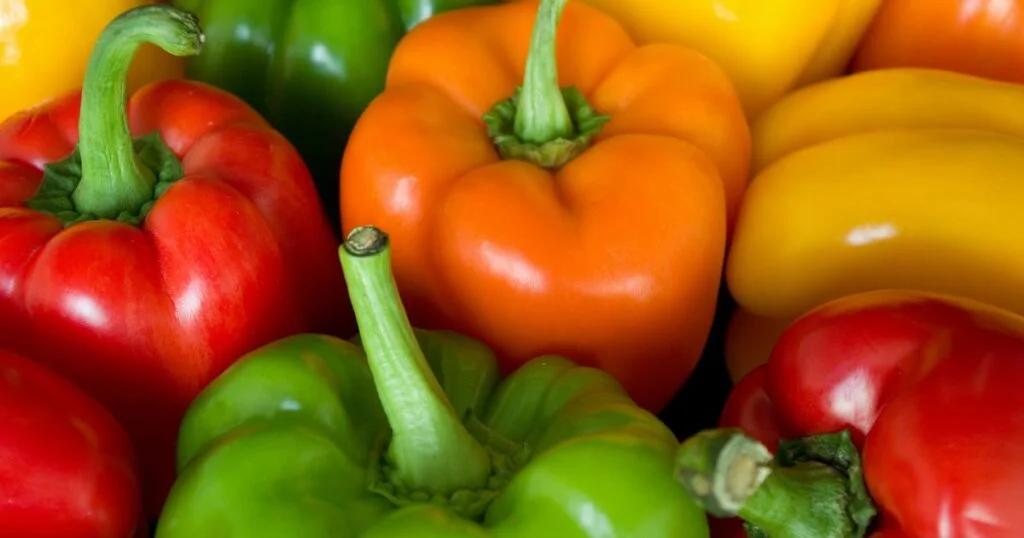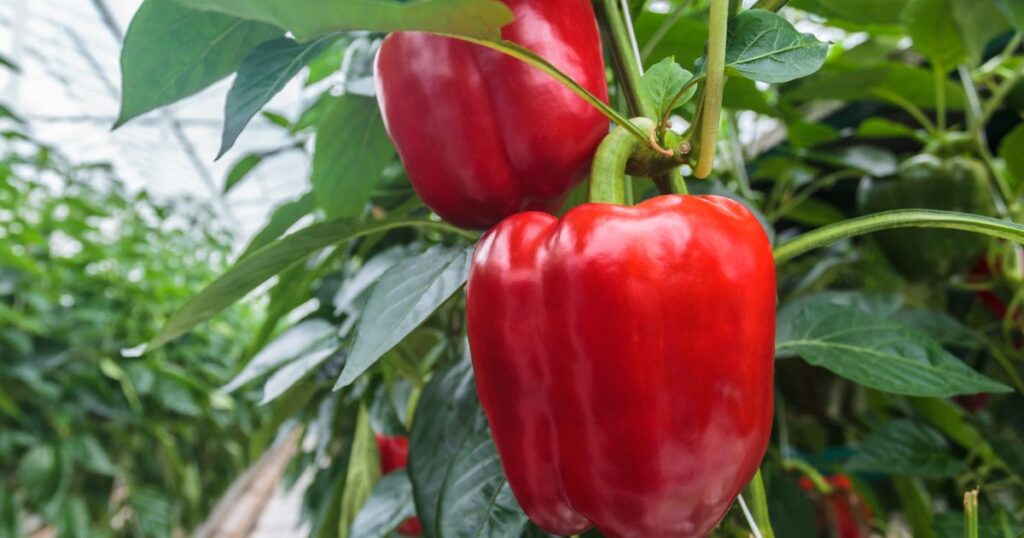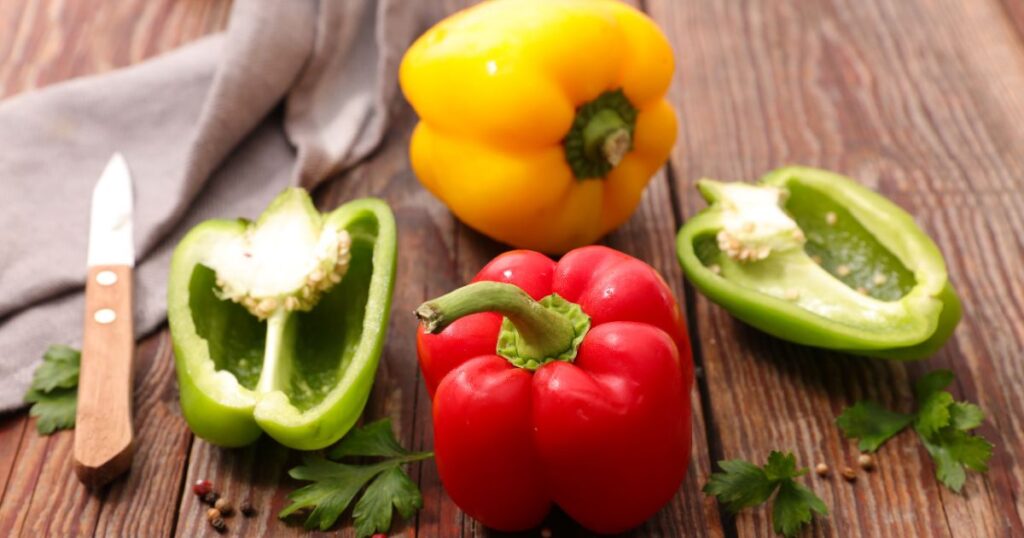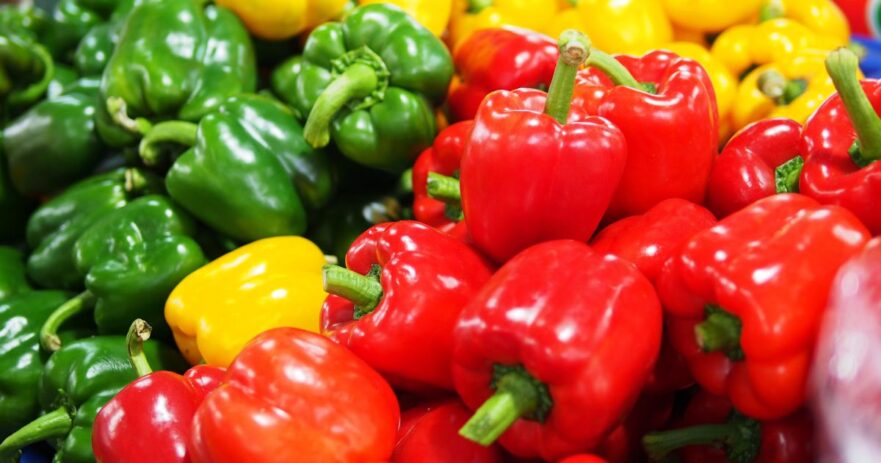In this article about bell pepper:
🗺️ Origin and history | 🌶️ Uses | ✨ Appearance and taste | 🌶️ Types | 🧑🌾 Growing – gardening | 👨🍳 Cooking – recipes | 🛒 Where to buy | 🫙 How to store | 👨⚕️ Health benefits | 🌶️ Alternatives and substitutes | ❓ Frequently asked questions
What is a Bell pepper?
Bell peppers, also called capsicums or sweet peppers, are a popular non-spicy pepper native to Central and South America. They come in various colors, including green, red, yellow, and orange, often found in supermarkets and farmers’ markets. Bell peppers are part of the Capsicum annuum family and are closely related to other pepper varieties such as jalapeños and cayenne peppers.
Unlike many other chili peppers, bell peppers are sweet and mild, with a Scoville heat rating of zero. This makes them an incredibly versatile ingredient in various dishes, adding a delightful crunch and vibrant color to salads, stir-fries, stuffed peppers, and more. In addition, their mild flavor and crunchy texture make them a favorite for culinary applications, from appetizers to main courses.
| Bell pepper | |
| SHU | 0 - 0 |
| Median SHU | 0 |
| Flavor | Sweet and mild, with no heat |
| Species | Capsicum annuum |
| Origin | Mexico, Central America, the Caribbean and northern South America |
| Uses | Raw or cooked in a variety of dishes, salads, etc. |
Are Bell peppers spicy? How hot are they?
Bell pepper scoville: 0 SHU
Bell peppers are known for their mild and sweet taste, as they have a Scoville rating of zero, which means they are not spicy. To put this into perspective, jalapeños have a Scoville rating between 2,500 and 8,000 units, while hotter peppers like habanero can reach up to 350,000 units. Therefore, Bell peppers’ lack of spiciness makes them an ideal ingredient for those who enjoy the taste of peppers without the heat.
Numerous alternatives are available if you’re seeking a pepper with more heat. For example, Anaheim or poblano peppers can offer mild to moderate spice, while serrano or cayenne peppers provide a more intense heat.
🗺️ ORIGIN AND HISTORY
Where do Bell peppers come from?
Bell peppers are believed to have originated in Central America and northern South America, with their cultivation dating back thousands of years. These colorful and sweet peppers are used in various traditional cuisines throughout the region, including Mexican and Peruvian dishes.
Over time, Bell peppers have spread worldwide, becoming a staple in numerous culinary traditions. For example, they are prominent in Mediterranean dishes, often stuffed or roasted. In the United States, bell peppers are commonly used in various dishes, including salads, stir-fries, and fajitas, showcasing their versatility and appeal.
🌶️ USES
What are bell peppers good for? How to use them?
Bell peppers are incredibly versatile, offering a range of colors, flavors, and textures to dishes. As a result, they are popular in many international cuisines, including Mediterranean, Latin American, and Asian recipes.
One of the simplest ways to enjoy bell peppers is to incorporate them into salads, where their crisp texture and mild sweetness complement various other ingredients. Chop them up and add them to your favorite mixed greens to make a salad.
Bell peppers are also a fantastic addition to stir-fries and sautées, maintaining their vibrant color and crunch when cooked. In addition, they can be combined with other vegetables, proteins, and sauces to create flavorful and satisfying dishes. They are also often used in fajitas, where they are sautéed with onions and strips of marinated meat.
Roasting is another popular method to cook bell peppers; it brings out their natural sweetness and adds a rich, smoky flavor. Roasted bell peppers can be a side dish or incorporated into pasta sauces, sandwiches, or wraps. They are also used as a topping for pizzas, adding color and taste.
In addition, bell peppers can be stuffed with various fillings, such as rice, ground meat, or vegetables, and then baked to create a hearty, one-dish meal. Also, they can be pickled, puréed into sauces or soups, or used as a garnish. With their wide range of applications, bell peppers are a versatile and delicious ingredient.

✨ APPEARANCE AND TASTE
What does a bell pepper look like?
Bell peppers come in various shapes and sizes, ranging from 4 to 6 inches long and 3 to 5 inches in diameter. They generally have a rounded, somewhat elongated appearance with a slightly tapered bottom. They feature glossy outer skin and a hollow, segmented interior with numerous seeds. Depending on the variety and ripeness, Bell peppers are available in various colors, including green, yellow, orange, red, and purple. Unripe peppers are usually green and become more vibrant as they ripen, turning yellow, orange, or red.
What do bell peppers taste like?
Bell peppers have a distinct, mildly sweet, and slightly earthy flavor with a refreshing, crisp texture. Their taste varies based on color and ripeness. Green peppers, which are less ripe, tend to taste slightly bitter and grassy, while red, orange, and yellow peppers, which are more mature, have a sweeter and fruitier flavor.
Bell peppers become tender when cooked, enhancing their natural sweetness and creating a richer, more complex taste. Roasting particularly adds a delightful smoky nuance to the peppers’ flavor. However, bell peppers maintain their unique flavor regardless of the preparation method, making them a delicious and versatile addition to many dishes.
🌶️ TYPES
What are the different types of bell peppers?
Bell peppers come in various colors and flavors, each with unique characteristics. This section explores five notable types: red, green, white, yellow, and orange.
The red bell pepper is known for its vibrant red hue and sweet, mild taste. It is fully ripened and has the highest nutritional content among bell peppers. Red bell peppers are used in various dishes, from salads and stir-fries to roasted pepper dishes and stuffed peppers.
Green bell peppers are the unripe versions of their more colorful counterparts. As such, they have a slightly bitter, grassy flavor and firmer texture. Green bell peppers are used in many dishes, including fajitas, stuffed peppers, and stir-fries.
White bell peppers, though less common, are a unique variety with a pale white color and a subtly sweet taste. They can be used similarly to other bell pepper varieties, adding novelty and visual appeal.
Yellow bell peppers are a vibrant and eye-catching member of the Capsicum annuum family, boasting a sunny yellow color and subtly sweet, mild flavor. Their natural sugars develop further as they ripen from green to yellow, enhancing their taste; they are ideal for adding a splash of color and sweetness to salads, stir-fries, and stuffed pepper recipes. Yellow bell peppers are a versatile ingredient that brightens any dish.
Orange bell peppers have a beautiful bright orange hue and sweet, fruity flavor. Like red bell peppers, they are fully ripened and make a delicious addition to salads, stir-fries, and grilled dishes.

🧑🌾 GROWING – GARDENING
How to grow Bell Peppers?
Cultivating bell peppers in a home garden can be a rewarding experience, particularly for those who appreciate their color and versatility. Accordingly, these peppers flourish in temperate climates with abundant sunlight, making them suitable for locations with moderately warm growing seasons. Bell peppers can be grown in pots or well-draining soil, ensuring they receive adequate water throughout their growth cycle. Providing regular fertilization is also crucial for a prosperous harvest.
When to pick Bell Peppers?
The ideal time to harvest bell peppers largely depends on the desired stage of maturity. Generally, depending on the variety, these peppers take 60-90 days to mature. Then, for a sweeter taste, allow the peppers to ripen further, transitioning from green to their final red, yellow, or orange hue. Harvesting bell peppers consistently encourages new growth and yields a continuous supply of these delightful vegetables.
👨🍳 COOKING – RECIPES
Cooking / Recipe ideas for bell pepper
Bell peppers are a versatile and flavorful ingredient, providing color, texture, and a mild sweetness to dishes. One of the most popular bell pepper recipes is stuffed bell peppers. The stuffing can include various ingredients, such as ground beef and rice, creating a delicious and hearty meal.
Italian stuffed peppers are another variation, blending Italian spices, cheeses, and sometimes chorizo for a more flavorful filling. Roasted bell peppers can be incorporated into dishes or as a stand-alone side dish. Cooking stuffed peppers in an air fryer quickly and conveniently achieves a crispy exterior and perfectly cooked filling.
Bell peppers also pair well with other proteins, such as chicken and cheese, creating wholesome and satisfying dishes. In addition, they can be used to make soups, such as bell pepper and tomato soup, providing a rich and warming meal.
Bell pepper casserole is another delicious way to enjoy this versatile vegetable, combining various ingredients for a satisfying and filling meal. For those who enjoy preserving their garden harvest, canning roasted red peppers is a fantastic method to extend their shelf life and enjoy their flavor year-round.
With such a vast choice of options for cooking and incorporating bell peppers into recipes, they continue to be a popular ingredient in many dishes. Meanwhile, their versatility, taste, and nutritional value make them a fantastic addition to any meal.

🛒 WHERE TO BUY
Where can I buy bell peppers?
Bell peppers are widely available and can be found in most grocery stores or supermarkets in the produce section. They are typically sold in various colors, such as green, red, orange, and yellow. Fresh bell peppers can also be purchased at local farmer’s markets, where you may find varieties and colors not available in larger stores.
When selecting fresh bell peppers, look for those with vibrant color, smooth skin, and firm texture. Avoid peppers that are wrinkled, soft, or have dark spots, as these may be over-ripe.
Where can I buy bell pepper plants?
Gardening enthusiasts interested in growing their bell pepper plants can find them in garden centers or nurseries specializing in vegetable plants. Many online retailers also offer a selection of bell pepper plants for sale. When choosing plants, look for healthy specimens with sturdy stems and vibrant green leaves, avoiding any wilted or yellow leaves.
Where can I buy bell pepper seeds?
For those who prefer to grow bell peppers from seed, seeds can be found at local garden centers or purchased online through various retailers. When planting bell pepper seeds, follow the instructions on the seed packet and ensure they are placed in a sunny location with well-drained soil. With proper care and attention, you’ll soon have your very own crop of bell peppers to enjoy.
🫙 HOW TO STORE
How do I store bell peppers?
Fresh bell peppers can be stored in the refrigerator for up to two weeks, ensuring they remain crisp and retain flavor. To store them, place the peppers in a plastic bag or airtight container and keep them in the crisper drawer of your refrigerator. This helps maintain their texture and taste, allowing you to enjoy them for an extended time.
Pickled bell peppers have a longer shelf life than fresh ones and can be stored in the refrigerator for several months. Keep the peppers in their original jar with a tightly sealed lid for optimal storage, or transfer them to an airtight container before refrigerating. This helps preserve their flavor and texture.
As with any fresh produce, bell peppers can spoil over time. Some of the indicators that they are no longer suitable for consumption include dark spots, a foul odor, or a mushy texture. If you notice any of these signs, it’s probably best to discard the peppers to avoid eating spoiled food.
Can bell peppers be frozen?
Freezing is another practical option for storing bell peppers. First, wash the peppers thoroughly and remove the stems and seeds. Then, slice the peppers into the desired size, and place them in a single layer on a baking sheet. Finally, put the baking sheet in your freezer for several hours. Once frozen, transfer the bell peppers to an airtight container or plastic freezer bag, and store them in the freezer for up to six months. When ready to use them, remove the peppers from the freezer and thaw.
❤️🩹 HEALTH BENEFITS
Are bell peppers healthy?
Bell peppers are a nutritious, healthy addition to your diet. Low in calories and high in fiber, they are packed with essential vitamins and minerals, making them a great vegetable. Meanwhile, bell peppers are particularly rich in vitamin C, which helps support the immune system and promotes overall health and well-being.
Bell peppers also contain various antioxidants, such as carotenoids, which can have multiple health benefits. For example, these antioxidants may protect the body against damage from free radicals, which can lead to chronic diseases and aging.
Bell peppers are also a good source of vitamins A, E, and B6 and folate, potassium, manganese, and other essential nutrients. Accordingly, these vitamins and minerals contribute to eye health, promote healthy skin and support metabolism.
It’s really vital to note that bell peppers are suitable for most individuals, as they do not contain capsaicin, the compound responsible for the heat of spicier peppers. This makes them mild and sweet, allowing people who are sensitive to spicy foods to enjoy them.
🔄 ALTERNATIVES AND SUBSTITUTES
What is a good bell pepper alternative?
If you are searching for a suitable substitute for bell peppers, several options can accommodate different tastes and recipe requirements.
Poblano peppers can be a viable alternative, especially when seeking a mild, slightly spicy flavor similar to bell peppers. These large, dark green peppers are ideal for stuffing, roasting, or incorporation into various dishes. However, poblano peppers have a thicker skin, which may require peeling after roasting.
Anaheim peppers offer another option. They have a mild heat and a slightly sweet taste. These long, green peppers can be used in recipes that call for bell peppers, such as stir-fries, salads, or fajitas. However, their thinner skin makes them less suitable for stuffing.
For those looking for a sweeter alternative, consider using sweet mini-peppers. These small, colorful peppers closely resemble bell peppers in taste but have thinner skin and smaller sizes. They are great for snacking, salads, or topping dishes like pizza and sandwiches.
If heat is no problem, jalapeño peppers can be used to add a kick to your recipe. When using jalapeños as a bell pepper substitute, remove the seeds and membranes to minimize their heat. In addition, Jalapeños can be incorporated into various dishes that call for a touch of spice, including salsas, poppers, and stir-fries.
How do you pronounce bell peppers?
Bell peppers are pronounced bel pep-pers, with a clear, distinct enunciation.
🙋 FREQUENTLY ASKED QUESTIONS
FAQ about bell peppers
Are bell pepper seeds edible?
Yes, bell pepper seeds are edible, but they taste slightly bitter. As a result, some people remove the seeds before eating or cooking bell peppers to improve their dishes' overall flavor and texture.
Are bell peppers spicy?
Bell peppers are not spicy, as they lack the capsaicin compound responsible for the heat in chili peppers. Instead, they are considered sweet peppers and add a mild, slightly sweet flavor to dishes.
Are bell peppers keto?
Yes, bell peppers are keto-friendly, as they are low in carbs and high in fiber, making them suitable for a ketogenic diet. In addition, they can be used as a healthy ingredient in various keto recipes.
Are bell pepper plants perennial?
Bell pepper plants are generally treated as annuals but can be grown as perennials in warm climates. However, their production typically declines after the first year.
Are bell pepper leaves edible?
While bell pepper leaves are not toxic, they are not often consumed due to their slightly bitter taste and tough texture. Instead, it‘s generally better to focus on the fruit.
Can bell peppers cause heartburn?
Bell peppers are less likely to cause heartburn than spicy peppers as they lack capsaicin. However, individual sensitivities may still cause discomfort for some people.
Can bell peppers be eaten raw?
Yes, bell peppers can be eaten raw and are often used in salads, sandwiches, or as a crunchy snack. They provide a crisp texture and a refreshing, slightly sweet taste.
Can bell peppers cause diarrhea?
Although bell peppers are not typically associated with diarrhea, individual sensitivities or consuming excessive fiber may occasionally lead to digestive issues.
What bell pepper is best for chili?
Red bell peppers are the best choice for chili, as they have a slightly sweeter and more mature flavor than their green counterparts. They complement the flavors of chili without adding heat.
Do bell peppers have the most vitamin C?
Bell peppers are an excellent source of vitamin C, with red bell peppers containing the highest amount among the varieties. In addition, they provide more vitamin C per serving than oranges, making them great for boosting your immune system.

